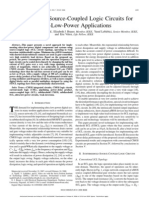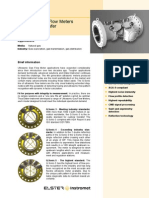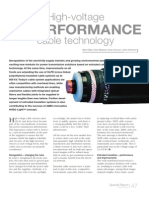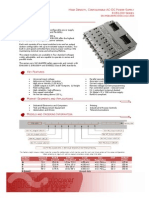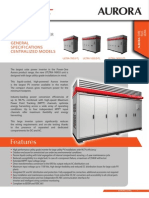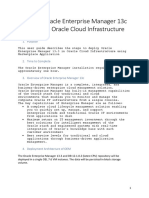250T Frequency Transmitter
250T Frequency Transmitter
Uploaded by
reality88Copyright:
Available Formats
250T Frequency Transmitter
250T Frequency Transmitter
Uploaded by
reality88Copyright
Available Formats
Share this document
Did you find this document useful?
Is this content inappropriate?
Copyright:
Available Formats
250T Frequency Transmitter
250T Frequency Transmitter
Uploaded by
reality88Copyright:
Available Formats
User's Manual: Series 250T Model 250T Frequency Input Two-Wire Transmitters
Table of Contents Introduction Description Specifications Specifications (Display Option) Installation Calibration General Maintenance List of Drawings Typical Installation & Simplified Schematic (4501-077) Electrical Connections: DC C/V Input (4501-093) Configuration Jumper Location (4501-095) Dimensions: DIN Rail Mounting (4501-080) Dimensions: Surface & Snaptrack Mtg. (4501-081) Mechanical Assy: Mtg -XP Enclosures (4501-082) NEMA 4 & 12 Enclosures (4501-083) Explosion Proof Enclosure (4501-084) Explosion Proof Enclosure, with Window (4501-085)
Page 1 1 2 4 4 5 6 Page 7 7 8 9 9 10 10 11 11
INTRODUCTION: These instructions cover the model types listed in Table 1 below. Supplementary sheets are attached for units with special options or features. Table 1: A. Model Number Format: 250T-Input-Mounting/Display-Certification-Calibration B. Typical Model Number: 250T-FQ1-XP-NCR-C Series 250T -Input -FQ1 -Mtg/Display -DIN -SM -ST -N4 -N12 -XP -XPD1 -XPD2 -XPD3 -Certification -NCR -Approval2 -Calib. (Blank) -C1
IMPORTANT SAFETY CONSIDERATIONS
Notes (Table 1): 1. Unit can be ordered with or without the factory calibration "-C" option. All other input types automatically include calibration to customer specifications (no "-C" needed). Any customer specified calibration info will be included on a separate calibration label on the unit. 2. Consult the factory for current information on agency (e.g. Canadian Standards Association, etc.) approvals.
It is very important for the user to consider the possible adverse effects of power, wiring, component, sensor, or software failures in designing any type of control or monitoring system. This is especially important where economic property loss or human life is involved. It is important that the user employ satisfactory overall system design. It is agreed between the Buyer and Acromag, that this is the Buyer's responsibility.
DESCRIPTION: The Model 250T Frequency Input, Two-Wire Transmitter accepts a periodic or pulse waveform signal (such as those originating from tachometers, magnetic transducers and turbine flow meters), and provides a 4-20mA process current output directly proportional to the signal frequency. The input circuit is direct coupled, fully isolated, and can accept signal amplitudes from +/25mV to 150V RMS. Any one of ten input frequency ranges, from 25 Hz to 25,600 Hz spans, can be easily selected by changing one jumper (shunt) on a digital divider network. These transmitters are RFI-protected, operate over a wide temperature range, and feature excellent temperature coefficients, which minimize the effects from harsh plant environments. Other features of this unit include the following: A quartz crystal time-base design is used for improved temperature performance. Three filter network time constants (field selectable) are provided to optimize output response-time and ripple characteristics. Two input threshold circuits are provided (field selectable).
Acromag, Inc. 30765 South Wixom Road P.O. Box 437 Wixom, Michigan 48393-7037, USA
Tel: (248) 624-1541 FAX: (248) 624-9234
Copyright 1991, 1994, Acromag, Inc., Printed in the USA. Data and specifications are subject to change without notice
8500-286-E01K012
-1-
Series 250T User's Manual Frequency ___________________________________________________________________________________________
One for bipolar (zero crossing) signals and one for unipolar (nonzero crossing) signals. In the bipolar mode, the transmitter has a zero volt threshold and fixed hysteresis. If configured in the unipolar mode, the module has a 1.5 volt threshold and fixed hysteresis. In addition, the unipolar mode provides an excitation or pull-up circuit. This excitation allows interfacing to passive frequency inputs such as with "dry-rated" contact closure and open collector transistor switching. Following basic two-wire design, the output and the DC power share the same pair of twisted copper wires. The transmitter acts similar to a variable resistor in series with the load and DC supply, and provides an output loop current proportional to the input sensor signal. See Drawing 4501-077 for a typical installation. The transmitter is available for DIN-rail mounting, Surface Mounting, 3-inch SNAPTRACK plastic rail mounting, or in various housings. These housings include NEMA 4, 12, and explosionproof enclosures. The model number specifies the mounting/ enclosure type. The transmitter mounted in the explosion-proof enclosure is available with a 3 1/2 digit LCD (1/2-inch height) readout for a visual indication of the transmitter's output. The readout is available as a percent of span or engineering units, scaled to customer requirements. Input wiring is inserted in the bottom of the unit, while output wiring is inserted on the top of the unit. Screws to secure the wiring are located on the front panel. Connectors are screw-clamp type and accept wire size up to #14 AWG. Isolation: The input circuit is electrically isolated from output/power circuits allowing the input to operate at up to 250V AC or 354V DC off ground on a continuous basis (will withstand 1500V AC dielectric strength test for one minute without breakdown). Complies with test requirements outlined in ANSI C39.5-1974 for the voltage rating specified. Output: 4-20mA DC output. Note: A Test Signal of 40mV to 200mV is available at the output terminals, (see Drawing 4501-093); it represents the 4 to 20mA output. Power: An external loop power supply is required: 12V DC minimum, 50V DC maximum. Under no circumstances must the DC supply ever exceed 75 volts peak instantaneously. Unit has reverse polarity protection. Output Limits (typical): 3.8mA DC to 26mA DC (typical). Load Resistance Range Equation: R-Load (Maximum) = (V supply - 12V) / 20mA. At 24V supply, R-Load = 0 to 600 ohms. Power Supply Effect: DC Volts: 0.001% of output span per volt DC. 60/120 Hz ripple: 0.01% of output span per volt peak to peak of power supply ripple. Input Circuit Open Response: Down-scale drive standard. Bipolar Input Configuration (configured by internal jumper): Threshold: 0.0V DC. Input Amplitude: 25mV to 150V RMS. Hysteresis: Fixed: 25mV, nominal. The switching points are -25mV and +25mV (nominal), or 0.0V 0.025V. Unipolar Input Configuration (configured by internal jumper): Threshold: 1.5V DC. Attenuator resistors may be installed on the PC board to further reduce sensitivity by raising the threshold level, consult factory. Hysteresis: Fixed: 25mV, nominal. The switching points are +1.525V and +1.475V (nominal), or +1.5V 0.025V. Input Amplitude: 0 to 2V to 150V RMS. Unipolar Excitation Supply: In unipolar mode, the (L) terminal provides an excitation supply for contact closure or open collector transistor switching circuits. Nominal excitation/pull-up is 5V DC through 15K ohms (0.333mA, nominal). Note: If input leads are long, capacitance developed across the input leads could limit use to lower frequencies. Minimum Pulse Width: 10uS, minimum required. Reference Test Conditions: Input: 0 - 12,800 Hz, 100 ohm resistive source; Output 4-20mA into 500 ohm load; 77oF (25oC); 24V DC supply. Accuracy: 0.1% of calibrated span. The error includes the combined effects of transmitter repeatability, hysteresis, terminal point linearity and adjustment resolution. Ambient Temperature Range: -13oF to 185oF (-25oC to 85oC). Ambient Temperature Effect: Less than 0.01% of output span per oF (0.018% per oC) over ambient transmitter range for
SPECIFICATIONS: Function: This two-wire transmitter accepts a frequency, periodic, or pulse waveform input signal, provides input circuit isolation, and converts this signal to a 4-20mA process current output. Wide range zero and span adjustments utilize 22-turn potentiometers accessible from the front of the unit. The transmitter has various mounting and enclosure options. MODEL/SERIES: 250TINPUT: Frequency: direct coupled input, span ranges 25 to 25,600 Hz; input impedance 50,000 ohms typical. Input span and zero ranges are adjustable as specified below, except for special ranges which are factory calibrated per customer specifications. -FQ1: Frequency: Span 25 to 25,600Hz, Zero: 0-20% of Span. The input span is continuously adjustable over the preselected input span range. The minimum input frequency for any range can be from 0-20% of full scale frequency. FQ Range A: FQ Range B: FQ Range C: FQ Range D: FQ Range E: FQ Range F: FQ Range G: FQ Range H: FQ Range I: FQ Range J: Span: Span: Span: Span: Span: Span: Span: Span: Span: Span: 25 50 100 200 400 800 1,600 3,200 6,400 12,800 to to to to to to to to to to 50 Hz 100 Hz 200 Hz 400 Hz 800 Hz 1,600 Hz 3,200 Hz 6,400 Hz 12,800 Hz 25,600 Hz
-2-
Series 250T User's Manual Frequency ___________________________________________________________________________________________
reference test conditions. Includes combined effects of zero and span over temperature. Load Resistance Effect: Less than +0.005% of output span for 100 ohm change. Output Ripple: Less than 0.5% of maximum output span for inputs from 10-100% of full-scale when recommended filter is selected. This can be reduced to less than 0.1% by adding a one (1) uf capacitor across the load. Bandwidth: -3dB at 25,600 Hz, typical. Response Time: Shunt block selection of the filter networks on the PC Board will result in different response times. Standard unit is shipped with the 0.4 second response filter. To maintain low output ripple, for each frequency range, use the recommended filter. For a step change in the input frequency, the nominal response time for a 98% change of the output span is specified below. Install shunt blocks per Table below. Table: Frequency Range/Response Time Selection Response Frequency Filter Jumpers Time (98%) Span Range Jumper Block:J1 (shunt) 8.0 sec. A thru J Pins 1 & 3 Pins 2 & 4 5.0 sec. C thru J Pins 3 & 5 Pins 2 & 4 0.4 sec. D thru J Pins 3 & 5 Pins 4 & 6 Noise Rejection: Common Mode: 115dB, 60 Hz, 100 ohm unbalance, typical. Radiated Field Immunity (RFI): Complies with IEC1000-4-3 (3 V/m, 80 to 1000MHz AM & 900MHz. keyed) and European Norm EN50082-1 with error less than 1.0% of FSR. Conductive Immunity: Complies with IEC1000-4-6 (3 V/m, .15 to 80MHz) and European Norm EN50082-1 with error less than 1.0% of FSR. Electromagnetic Interference Immunity (EMI): Error is less than 0.25% of FSR under the influence of EMI from switching solenoids, commutator motors, and drill motors. Electrostatic Discharge Immunity (ESD): Complies with IEC1000-4-2 Level 3 and European Norm EN50082-1. Surge Immunity: Complies with IEC1000-4-5 Level 1 (0.5KV) and European Norm EN50082-1. Electric Fast Transient Immunity (EFT): Complies with IEC10004-4 Level 3 and European Norm EN50082-1. Radiated Emissions: Complies with European Norm EN50081-1 for class B equipment. Construction (Basic Transmitter): Circuit Boards: Military grade FR-4 epoxy glass circuit board. Circuit Board Coating: Fungus resistant acrylic conformal coat. Terminals: Compression type, wire size 14 AWG max. Mounting Position: Position insensitive. Case: Self-extinguishing NYLON Type 6.6 polyamide thermoplastic UL94 V-2, color black. General Purpose, NEMA Type 1 enclosure. MOUNTING/DISPLAY: A wide variety of mounting options and enclosures are available to meet the needs of the installation. The available models are listed below. The transmitter is shipped as a complete assembly. General Purpose Housing: Available with various mounting options listed below. Case: Self-extinguishing NYLON Type 6.6 polyamide thermoplastic UL94 V-2, color black. -DIN: General Purpose Housing, DIN Rail-Mount - "G" & "T" rails. "G" Rail (32mm), Type EN50035; "T" Rail (35mm), Type EN50022. Refer to Drawing 4501-080 for outline and clearance dimensions. Shipping Weight: 1 pound (0.45Kg) packed. -SM : General Purpose Housing, Surface-Mount. Refer to Drawing 4501-081 for outline and clearance dimensions. Shipping Weight: 1 pound (0.45Kg) packed. -ST: General Purpose Housing, SNAPTRACK. Refer to Drawing 4501-081 for outline and clearance dimensions. Shipping Weight: 1 pound (0.45Kg) packed. SNAPTRACK is a registered trademark of Reed Devices, Inc. NEMA 4 and 12 Enclosures: Option types listed below. Refer to Drawing 4501-083 for outline and clearance dimensions. Transmitter is mounted within enclosure at the factory. These enclosures may accommodate a second transmitter with the surface-mount option (-SM option, ordered separately). Conduit mounting holes and fittings are customer supplied. -N4: Water-Tight Enclosure, NEMA 4. Enclosure material and finish: 0.075 and 0.060 inch thick steel with gray hammertone enamel finish inside and out. Shipping weight: 6 pounds (2.7Kg) packed. -N12: Oil-Tight Enclosure, NEMA 12. Enclosure material and finish: 0.075 and 0.060 inch thick steel with gray hammertone enamel finish inside and out. Ship. weight: 6 pounds (2.7Kg) packed. Explosion Proof, Water-Tight Enclosures: Option types listed below. Refer to Drawing 4501-084 (no display window) or Drawing 4501-085 (with display window) for outline and clearance dimensions. Enclosure Materials: Body and cover Copper-free aluminum (less than 0.4%), Glass lens - Heat tempered glass, Gasket - Neoprene. Finish: Corro-free epoxy powder coat, color gray. Hub size: 0.75 inch (Quantity 2). Housing meets Class I - Groups B, C, & D, Class II - Groups E, F, & G, Class III, and NEMA 4 (water-tight) requirements. Transmitter is mounted within enclosure at factory. -XP: Explosion Proof, Water-Tight Enclosure (No Window). Shipping weight: 5 pounds (2.3Kg) packed. -XPD1: Explosion Proof, Water-Tight Enclosure (With Window). Includes the Standard Display Option (D1). Shipping weight: 6 pounds (2.7Kg) packed. -XPD2: Explosion Proof, Water-Tight Enclosure (With Window). Includes the Temperature Display Option (D2). Shipping weight: 6 pounds (2.7Kg) packed. -XPD3: Explosion Proof, Water-Tight Enclosure (With Window). Includes the Engineering Units Display Option (D3). Shipping weight: 6 pounds (2.7Kg) packed.
-3-
Series 250T User's Manual Frequency ___________________________________________________________________________________________
DISPLAY OPTION: The Display is available as an option when specifying the "-XP" Housing. The linear display option assembly includes zero and span trim adjustments. Display Options include: -xxD1: Standard Display Option (D1): The minimum and maximum input (any calibration) is represented by 00.0 and 100.0% on the display (normalized). It also represents the 4 to 20mA transmitter output, a resolution of 0.1% of span. -xxD2: Temperature Display Option (D2): Not applicable. -xxD3: Engineering Units Display Option (D3): The minimum and maximum display readings correspond to the minimum and maximum display readings specified for the unit by the customer. Display Range: The minimum display reading can be from -1999 to +1999 counts, while the span range can be from 100 to 2000 counts (span counts = maximum counts minus minimum counts--Note: mentally remove the decimal point to determine the display counts). The decimal point is configured as required (such as 00.0 to 100.0%). Display Characteristics: The 7-segment reflective Liquid Crystal Display (LCD) contains 3-1/2 digits (1999) with 1/2 inch character height. Also includes a factory programmed 3 position decimal point. Optimal view angle is 60 degrees. No Output Burden: Provides a visual indication of the transmitter output without reducing the output compliance (the allowable load resistance range). Display Ambient Temperature Range: Operating: 0 to 50oC (+32 to +122oF); Storage: -20 to +70oC (-4oF to +158oF). Over-range: The three lower order digits blank for >1999 counts. Display Accuracy: (0.1% of reading + 2 counts). Display Ambient Temperature Effect: 0.02% per oC (0.012% per oF), typical. Conversion Rate: 2.5 per second. CERTIFICATION: Consult the factory for current information on the availability of agency (e.g. Canadian Standards Association, Factory Mutual, etc.) approvals. -NCR: No Certification Required. INSTALLATION: The transmitter is packaged in a general purpose plastic housing and optionally mounted within a variety of protective enclosures. The transmitter should be located in an area that is protected from dust, moisture, and corrosive atmospheres. The enclosure type determines the protection afforded in a particular environment and location, make sure that this is not compromised. Maximum operating ambient temperatures should be within -13 oF to 185oF (-25 oC to 85oC) for satisfactory performance. If unit is factory calibrated, it is ready for installation. Connect as shown in Connection Drawing 4501-093. If unit is not factory calibrated, refer to the "CALIBRATION" section. Mounting: Mount transmitter assembly - refer to appropriate outline drawing for mounting and clearance dimensions. Determine which configuration is utilized and consult the proper mounting instructions listed below. 1. DIN Rail Mounting: Using suitable fastening hardware, secure the DIN rail to the designated mounting surface. A transmitter ordered with the DIN Rail mounting option (-DIN) can be mounted to either the "T" or "G" Rail. Installation of the transmitter to the rail depends on the type of DIN rail used (see Drawing 4501-080). Units can be mounted sideby-side on 1.0-inch centers, if required. Surface Mounting: Secure the transmitter to the designated mounting surface using two 6-32 screws. Note that the mounting bracket has screw slots to facilitate mounting. Units can be mounted side-by-side on 1.0-inch centers, if required. SNAPTRACK Mounting: Secure the SNAPTRACK mounting channel to the designated mounting surface using suitable fastening hardware. To install the unit in the mounting channel, place the bottom end of the mounting bracket between the rails and press the top (notched end) firmly until the bracket "snaps" into place. To remove the transmitter, insert a screwdriver into the upper arm of the connector, twist to release the unit from the track and tip the unit out. Units can be mounted side-by-side on 1.0-inch centers, if required. NEMA 4 & 12 Enclosure Mounting: Secure the enclosure assembly to the designated mounting surface using appropriate hardware. The transmitter is secured within this enclosure using two screws. Note: It is recommended that the transmitter be removed from the enclosure during the process of drilling holes, installing fittings, and mounting the enclosure. Explosion-Proof Mounting: Secure the enclosure assembly to the designated mounting position using appropriate hardware. Note: It is recommended that the transmitter be removed from the enclosure during the process of mounting the enclosure. To remove unit from the enclosure, remove the two screws securing it to the bottom of the enclosure. After enclosure is installed, install the transmitter into enclosure. Position the unit at an angle that permits all wiring to be routed unobstructed through both ports. If the transmitter has the display option, make sure the orientation of the display allows for easy reading once installed. Secure the transmitter assembly to the enclosure using two screws. Electrical Connections: The wire size used to connect the unit to the control system is not critical. All terminal strips can accommodate wire from 14-26 AWG. Strip back wire insulation 1/4-inch on each lead before installing into the terminal block. Input wiring may be shielded or unshielded twisted pair. Output wires should be twisted pair. Since common mode voltages can exist on signal wiring, adequate wire insulation should be used and proper wiring practices followed. It is recommended that the output/power wiring be separated from the signal wiring for safety, as well as for low noise pickup.
2.
3.
4.
5.
-4-
Series 250T User's Manual Frequency ___________________________________________________________________________________________
1. Output/Power: Connect DC power supply and load per connection diagram, refer to Drawing 4501-093. These transmitters operate from DC power supplies only. Power supply voltage is not critical and normally should be from 12-50V DC. The supply voltage must not exceed 75 volts even instantaneously. The power supply voltage must be adequate to furnish full-scale current to the load(s), plus transmission line drop, plus 12V DC terminal voltage to the transmitter. Variations in power supply voltage or load resistance have negligible effect on transmitter accuracy. Ripple and Noise: Power supply ripple at 60Hz/120Hz is reduced at the load by the transmitter. The ripple at the load will be 0.01% of span per volt peak to peak of power supply ripple. The unit may have up to 0.25 percent of internally generated ripple; connect an external luf capacitor across the load to reduce this ripple to less than 0.1 percent if desired. 2. Grounding: The two-wire transmitter in the General Purpose Housing is plastic and does not require an earth ground connection. If the transmitter is mounted in a metal housing, a ground wire connection is required. Connect the ground terminal (green screw) to a suitable earth ground using suitable wire per applicable codes. Input: Connect input per Drawing 4501-093. If unit is factory calibrated, the calibration label indicates range of input. Note: The input circuit is electrically isolated from the output/power circuit, allowing the input to operate up to 250V AC, or 354V DC, off ground on a continuous basis. Disassembly Procedure for the 250T Plastic Housing: The plastic housing has no screws and "snaps" together. A flathead screwdriver (Acromag 5021-216 or equivalent) is needed to pry the housing apart as described in the following steps. CAUTION: Do not push screwdriver blade into the housing more than approximately 0.1 inches while prying it apart. Handling of printed circuit boards should only be done at a static-free workstation, otherwise, damage may occur. 1. To begin disassembly (refer to Drawing 4501-095) place the screwdriver at point A (left side of the transmitter). While pressing the blade into the seam, use a twisting motion to separate the sides slightly. Repeat this operation at point B. 2. Now that the two pieces have been partially separated, use the screwdriver blade to work the left side of the package loose by working around the transmitter and carefully prying the sides further apart. Repeat this action until it is easy to remove the left side from the plastic pins holding the pieces together. 3. Repeat 1 & 2 for the right side starting at points C and D. CAUTION: If the two boards become separated while taking the package apart, re-align the boards making sure that both headers (pins) and sockets at locations E and F are aligned and carefully push the boards back together. Jumper Configuration (Shunt Blocks): Shunt blocks are provided to accommodate in-field configuration changes. In case of misplacement, additional shunt blocks may be ordered from the factory. When ordering additional shunt blocks, refer to Acromag Part Number 1004-332. 1. Input Conditioning Selection: Determine whether the input signal is a zero-crossing or a non-zero-crossing signal. The sinusoidal output from a passive magnetic pickup is a typical "zero-crossing" signal. A typical TTL output is a "non-zerocrossing" type. Refer to table 2 on Drawing 4501-095 for proper jumper (shunt) position. 2. Input Frequency Range: Select the desired frequency range for the input signal and place the shunt block in the required range position, A through J. Refer to table 3 on Drawing 4501095 for proper jumper (shunt) position. Note: for best results, select the smallest frequency range that will cover the frequency span being monitored. 3. Output Ripple/Response Time: Select the filter for desired results. Refer to table 1 of Drawing 4501-095 for proper jumper (shunt) position. Refer to "Response Time" in the preceding "SPECIFICATIONS" section, which describes the frequency/response-time combinations that can be achieved, while maintaining less than 0.1% output ripple from 10 to 100% of full-scale. Faster response-times may be used when output ripple is not critical. Non-factory calibrated units have a 0.4 second response time. 4. Important: Mark the Transmitter's Configuration on the calibration label located on the enclosure. Example: IN: Bipolar, Range "I"; 0 to 12,800Hz Filter - 3; 0.4 seconds.
3.
CALIBRATION: A. TRANSMITTER: This section provides information for unit configuration and calibration. If the unit was factory calibrated, jumpers have been placed in their proper positions and verification of the calibration can be made per the Adjustment Procedure. If the calibration of the unit is to be changed, first go to the "Shunt Block Configuration Procedure" before going to the Transmitter Adjustment Procedure." 1. Transmitter - Shunt Block Configuration Procedure: The Frequency transmitter is quite universal in that it can be configured for Unipolar or Bipolar input signals, a large number of frequency ranges and ripple/response filtering. Before the adjustment procedure can proceed, the jumpers have to be configured to the requirements of the application (refer to Drawing 4501-095). To gain access to the Configuration Jumpers, remove transmitter from the installation first. Second, remove the circuit boards from the plastic enclosure as described in the Jumper Configuration procedure below. Third, configure jumpers (shunt blocks) as described in the Jumper Configuration procedure below. Note, calibration per the Adjustment Procedure should be performed before the circuit boards are reassembled within the plastic enclosure.
-5-
Series 250T User's Manual Frequency ___________________________________________________________________________________________
Jumper Configuration Example: The following is the jumper configuration for the example below, configure your own unit as required for your application: A. Unipolar/Bipolar: Bipolar. (Shunt J1 pins 9 & 10). B. Frequency Range: Range "I"; 0 to 12,800Hz. (Shunt J2 position I) C. Ripple/Response: 0.4 sec. (Shunt J1 pins 3 & 5, 4 & 6). Transmitter - Adjustment Procedure: Connect the transmitter as shown in Connection Drawing 4501-093. The input signal source must be adjustable over the entire frequency range (0-25,600 Hz) of the transmitter. In addition, the frequency source must be adjustable and stable to any specific frequency with an accuracy of 0.1% or better. Signal amplitude should be set at a level representative of the actual input signal. It is recommended that a frequency counter be used to measure input frequency, as most dial markings are not accurate. The transmitter power supply voltage must be adequate to furnish full-scale current to the load, plus wire drop, plus 12V DC terminal voltage to the transmitter. The output current must be measured to 0.1% accuracy or better for proper results. The Zero and Span adjustments are accessible on the front panel of the transmitter (see Drawing 4501-093 for location). The screwdriver blade used to adjust the potentiometers should not be more than 0.1 inch (2.54mm) wide. Transmitter - Calibration Example: Model : 250T-FQ1-XPD1-NCR Input : 0-12,800 Hz, bipolar input, filter: 0.4 sec response. Output : 4-20mA DC. 1. The calibration signal amplitude requirements are a function of the "Input Conditioning Type" selected. A. Unipolar (Threshold: 1.5V DC Nominal), use a 0-2.0V signal or greater. B. Bipolar (Threshold: 0.0V DC Nominal), use a 0.2V signal or greater. 2. Set the input frequency to 0 Hz. Adjust the Zero (Z) pot until the output reads 4.000mA DC. If the output cannot be reduced to 4.000mA, turn the "Span" pot counter clockwise until the output is reduced to the desired value. Note: If the minimum input is 0 Hz, it can be simulated by temporarily disconnecting the signal generator and shorting the input terminals of the transmitter. Before going to Step 3, remove the short circuit and connect the signal generator to the input terminals. 3. Set the input frequency to 12,800 Hz. Adjust the Span (S) pot until the output reads 20.000mA DC. 4. Repeat Steps 2 and 3 above, until the readings converge. The instrument is now calibrated. Several mid-point values should also be checked to verify proper operation of the transmitter. 5. After the above calibration procedure is complete, install the transmitter board assembly back into its case as described in the assembly procedure below. Note: If the transmitter has the Display Option, install it at this time also. Assembly Procedure for the 250T Plastic Housing: NOTE: The Model/Serial Number label is on the left side. 1. Refer to drawing 4501-095 and line up the left plastic side with the board and terminal assembly. Carefully but firmly press the pieces together. 2. Before installing the right side, place the mounting bracket (unique to the mounting type you have) around the pins at the back of the housing. 3. Line up the right side of the housing with the assembly and carefully but firmly press the pieces together.
B. DISPLAY: Display - Adjustment Procedure: If the unit you are calibrating has a display, it is calibrated separately from the transmitter. The calibration of the transmitter must be verified FIRST (see above procedure), before verifying the calibration of the display module. Refer to Drawing 4501-093 for location of Transmitter's Zero and Span adjustments and the location of the Display's Zero and Span adjustments. NOTE: The display option is factory configured for a particular customer specified range -- the Display Zero (DZ) and Display Span (DS) adjustments are trim adjustments only. Display - Calibration Example: Model: 250T-FQ1-XPD1-NCR Input: 0 to 12,800Hz Display: 0 to 1280 counts (x 10 = 12,800Hz.) 1. Set the frequency input to 0Hz (the Zero point of the transmitter's span). Adjust the Display Zero (DZ) pot of the display module to the zero of the display range, 0000 in this example. 2. Set the frequency input to 12,800Hz (the full-scale point of the transmitter's span). Adjust the Display Span (DS) pot of the display module to the correct full-scale display reading, 1280 (x 10 = 12,800Hz) in this example. 3. Repeat steps 1 and 2 until the readings converge. The display is now calibrated.
GENERAL MAINTENANCE: The transmitter contains solid-state components and requires no maintenance, except for periodic cleaning and calibration verification. When a failure is suspected, a convenient method for identifying a faulty transmitter is to exchange it with a known good unit. It is highly recommended that a non-functioning transmitter be returned to Acromag for repair, since Acromag used tested and burned-in parts, and in some cases, parts that have been selected for characteristics beyond that specified by the manufacturer. Further, Acromag has automated test equipment that thoroughly checks the performance of each transmitter.
-6-
You might also like
- AN-101D Parking Sensor User Manual-202011-V1.3Document25 pagesAN-101D Parking Sensor User Manual-202011-V1.3Istar DMNo ratings yet
- Ipasolink - Catalog - 100 200 400 1000 PDFDocument2 pagesIpasolink - Catalog - 100 200 400 1000 PDFMohanad RazaqNo ratings yet
- Wireless Design Seminar 2006Document237 pagesWireless Design Seminar 2006wagnalang1639No ratings yet
- Radio Frequency SystemDocument8 pagesRadio Frequency SystemMAnohar KumarNo ratings yet
- MV and Synch Gear As Built-4Document35 pagesMV and Synch Gear As Built-4Sayed Younis SadaatNo ratings yet
- Level TransmitterDocument84 pagesLevel TransmitterKrishna KumarNo ratings yet
- Fotech Power System Monitoring 160919 SLDocument49 pagesFotech Power System Monitoring 160919 SLGia Bảo LưuNo ratings yet
- Sensornet Oct 2017-DAS-NASDocument13 pagesSensornet Oct 2017-DAS-NASListyo SurantoNo ratings yet
- HoneyWell Pressure TransmitterDocument22 pagesHoneyWell Pressure TransmitterSupawat Rangsiwong100% (1)
- Distributed Fiber Optic Sensors - Brillouin Optical Time Domain Analysis (BOTDA) Sensor in Simple LanguageDocument6 pagesDistributed Fiber Optic Sensors - Brillouin Optical Time Domain Analysis (BOTDA) Sensor in Simple LanguageInnovative Research PublicationsNo ratings yet
- 054604g0 Op Ackermann Katalog PDFDocument128 pages054604g0 Op Ackermann Katalog PDFABELWALIDNo ratings yet
- Investigations of Holographic DiffuserDocument36 pagesInvestigations of Holographic Diffusersubhra3sNo ratings yet
- UMTSDocument104 pagesUMTSHatem OdatAllahNo ratings yet
- 3D TVDocument21 pages3D TVtheplayer10080% (5)
- 21-2006Document10 pages21-2006Yogi FebriansyahNo ratings yet
- Cavicel - Fire Resistant CablesDocument37 pagesCavicel - Fire Resistant Cables2zeceNo ratings yet
- VelanDocument36 pagesVelanIslam Hosny MohamedNo ratings yet
- WGV1002 Api 6a Gate PDFDocument13 pagesWGV1002 Api 6a Gate PDFobumuyaemesiNo ratings yet
- Fibre Optic Transmission LinkDocument3 pagesFibre Optic Transmission Linknotkowsik007No ratings yet
- Design of Digital TV Receive System Based On DVB-TDocument4 pagesDesign of Digital TV Receive System Based On DVB-Tdesconoc9No ratings yet
- Bus Bar Calculation For 2500aDocument3 pagesBus Bar Calculation For 2500aInfoNo ratings yet
- Iec 62056-41Document25 pagesIec 62056-41nhnamNo ratings yet
- Understanding OM1, OM2, OM3, OS1, OS2 Fiber PDFDocument3 pagesUnderstanding OM1, OM2, OM3, OS1, OS2 Fiber PDFaldebaran0473No ratings yet
- Subthreshold Source-Coupled Logic Circuits For Ultra-Low-Power ApplicationsDocument12 pagesSubthreshold Source-Coupled Logic Circuits For Ultra-Low-Power ApplicationsSonu SangwanNo ratings yet
- Role of Losses in Design of DC Cable For Solar PV ApplicationsDocument5 pagesRole of Losses in Design of DC Cable For Solar PV ApplicationsMaulidia HidayahNo ratings yet
- Introduction To Instrumentation PDFDocument34 pagesIntroduction To Instrumentation PDFJuan Carlos Flores PoblanoNo ratings yet
- WirelessHART Technology - HARTOrgDocument8 pagesWirelessHART Technology - HARTOrgdavid_diaz_sNo ratings yet
- Temperature Sensors: Sensytemp Tsp311, Tsp321, Tsp331Document40 pagesTemperature Sensors: Sensytemp Tsp311, Tsp321, Tsp331Tin ThanNo ratings yet
- Sigma Catalogue 2015 PDFDocument60 pagesSigma Catalogue 2015 PDFZhu Qi WangNo ratings yet
- Ga422 Gnss Antenna and BracketDocument2 pagesGa422 Gnss Antenna and BracketmatohNo ratings yet
- Fiber Optic SensorsDocument11 pagesFiber Optic SensorsRahul KumarNo ratings yet
- Elster Instromet Q.sonicDocument2 pagesElster Instromet Q.sonicsaid_rahmansyah4750No ratings yet
- E4 - Experiment 4 - Level Transmitter CalibrationDocument17 pagesE4 - Experiment 4 - Level Transmitter CalibrationAfif Samsun BaharunNo ratings yet
- IET Lecture LV Wiring Design September 14Document36 pagesIET Lecture LV Wiring Design September 14HP LooiNo ratings yet
- 4 Wire Radar TransmitterDocument30 pages4 Wire Radar Transmitterpawank_kswnNo ratings yet
- 27 HV XLPErformance Cable TechnologyDocument6 pages27 HV XLPErformance Cable TechnologyRanaSinhaNo ratings yet
- BTEL Radio Transmission ATP Form v1.6Document19 pagesBTEL Radio Transmission ATP Form v1.6supriadi suhariNo ratings yet
- 2009 Annual Survey Report and Appendices-Phase IDocument82 pages2009 Annual Survey Report and Appendices-Phase ItoddflyNo ratings yet
- Full Digitally Controlled Power Supply DesignDocument61 pagesFull Digitally Controlled Power Supply DesignthietdaucongNo ratings yet
- DATA SHEET de Led Street LightDocument8 pagesDATA SHEET de Led Street LightNilson Eduardo Herrera RuizNo ratings yet
- Installers Guide Bs 8418Document2 pagesInstallers Guide Bs 8418mmhaq1975No ratings yet
- 3 - Unit 3 - Study Material - Wireless HART Communication Protocol OverviewDocument11 pages3 - Unit 3 - Study Material - Wireless HART Communication Protocol OverviewAnita DeshmukhNo ratings yet
- DC Motor With Permanent Magnet: PG 4520 PG 4520 PG 4525 PG 4525Document1 pageDC Motor With Permanent Magnet: PG 4520 PG 4520 PG 4525 PG 4525NewsUPdateNo ratings yet
- Cable Tie Sae StandardDocument9 pagesCable Tie Sae StandardSandeep Goud ChatlaNo ratings yet
- Buried Installation of Optic Fiber Cable: Application NotesDocument19 pagesBuried Installation of Optic Fiber Cable: Application NotesAli AbdulaleemNo ratings yet
- FOC InstallationProceduresDocument10 pagesFOC InstallationProceduresjahanzaibNo ratings yet
- Iecex Certificate of ConformityDocument3 pagesIecex Certificate of Conformitymlutfima100% (1)
- Cat6 U Utp Cable 1427071Document2 pagesCat6 U Utp Cable 1427071diepchidungNo ratings yet
- Fourier HolographyDocument3 pagesFourier HolographySahand NoorizadehNo ratings yet
- Cable Tray SystemsDocument7 pagesCable Tray SystemsRane SiddeshNo ratings yet
- Smart LoadDocument2 pagesSmart LoadAhmed MujtabaNo ratings yet
- Operation and Maintenance of A Substation-Libre PDFDocument60 pagesOperation and Maintenance of A Substation-Libre PDFShareef KhanNo ratings yet
- Itu-T: Characteristics of A Bending-Loss Insensitive Single-Mode Optical Fibre and Cable For The Access NetworkDocument22 pagesItu-T: Characteristics of A Bending-Loss Insensitive Single-Mode Optical Fibre and Cable For The Access NetworkAnand SrivastavaNo ratings yet
- Test Results Fluke Networks Qualification Tester Cableiq Fluke Networks Spse PresovDocument2 pagesTest Results Fluke Networks Qualification Tester Cableiq Fluke Networks Spse PresovMichalNo ratings yet
- How To Masters ThesisDocument3 pagesHow To Masters ThesisshaunlutherNo ratings yet
- PD Hawk: Switchyard PD Locator SAFELY Locates Internal Partial Discharge (PD) Activity in Open Terminal SwitchyardsDocument4 pagesPD Hawk: Switchyard PD Locator SAFELY Locates Internal Partial Discharge (PD) Activity in Open Terminal SwitchyardsOmaisNo ratings yet
- LIT1011 DelconRelaysDocument4 pagesLIT1011 DelconRelaysalltheloveintheworldNo ratings yet
- High Impedance Differential Protection 7VH60Document7 pagesHigh Impedance Differential Protection 7VH60Mohamed TalebNo ratings yet
- RCB1200 :: ROAL Living EnergyDocument10 pagesRCB1200 :: ROAL Living EnergyroalscribdNo ratings yet
- ULTRA-700 0 - 1040 0-1400 0-EN-New DC Recombiner PDFDocument4 pagesULTRA-700 0 - 1040 0-1400 0-EN-New DC Recombiner PDFAdrian Ioan POPNo ratings yet
- Az 400Document5 pagesAz 400Adrian Arellano SangamaNo ratings yet
- Sirius II User GuideDocument4 pagesSirius II User GuideJed Paul MinayNo ratings yet
- Chziri Zjr2 User ManualDocument51 pagesChziri Zjr2 User ManualJosé Henríquez V.No ratings yet
- Madloki Full Eps 1Document52 pagesMadloki Full Eps 1Tinie AnasNo ratings yet
- Project Report (TEAM 7)Document20 pagesProject Report (TEAM 7)Anshul MittalNo ratings yet
- Introduction To JavaScriptDocument37 pagesIntroduction To JavaScriptJyoti BhattNo ratings yet
- 3D PrintingDocument6 pages3D Printingkini vijethaNo ratings yet
- Quantum All ProductsDocument93 pagesQuantum All ProductsPavan Kumar DevathaNo ratings yet
- European National News - 2020 - Computer Law - Security ReviewDocument5 pagesEuropean National News - 2020 - Computer Law - Security ReviewSimone De Oliveira SouzaNo ratings yet
- Artificial Intelligence Theory and ApplicationsDocument32 pagesArtificial Intelligence Theory and Applicationskd17209No ratings yet
- C04 IntroMIPSAssemblyDocument15 pagesC04 IntroMIPSAssemblyLuís Manuel Dias RodriguesNo ratings yet
- Linear Algebra and Optimization For Machine LearningDocument18 pagesLinear Algebra and Optimization For Machine LearningSohail ZiaNo ratings yet
- Fine Aggregate IS 15155Document8 pagesFine Aggregate IS 15155Pratik KharmateNo ratings yet
- MOTOTRBO™ XiR M8600i SERIES DIGITAL TWO-WAY RADIOSDocument4 pagesMOTOTRBO™ XiR M8600i SERIES DIGITAL TWO-WAY RADIOSHerman GunawanNo ratings yet
- L7809CVDocument2 pagesL7809CVsoaresNo ratings yet
- Chakrabarthi-Streaming Alg BookDocument94 pagesChakrabarthi-Streaming Alg BookBalasubramanian RavikumarNo ratings yet
- Artigo - The Ambidextrous Organizations Managing Evolutionary and Revolutionary ChangeDocument24 pagesArtigo - The Ambidextrous Organizations Managing Evolutionary and Revolutionary ChangeElton Ribeiro100% (1)
- MIDAS FEA CatalogDocument24 pagesMIDAS FEA CatalogHattem IbrahimNo ratings yet
- Underwater Wireless Communication Seminar PPT and PDF ReportDocument2 pagesUnderwater Wireless Communication Seminar PPT and PDF ReportBeki Ye Biriye LijNo ratings yet
- PDF - 202173016277 - User Manual For Engineering Module PDF - CompressedDocument111 pagesPDF - 202173016277 - User Manual For Engineering Module PDF - CompressedShiv TomerNo ratings yet
- Installing Oracle Enterprise Manager 13c Release 3 in Oracle Cloud InfrastructureDocument5 pagesInstalling Oracle Enterprise Manager 13c Release 3 in Oracle Cloud InfrastructureTchakalaFissaleNo ratings yet
- Mohamed Rabia Mohamed Farage: Personal InformationDocument4 pagesMohamed Rabia Mohamed Farage: Personal Informationmohamed rabiaNo ratings yet
- TIB Hawk 4.9.0 RelnotesDocument58 pagesTIB Hawk 4.9.0 RelnotesWaqas Ali RazzaqNo ratings yet
- TOOLS 4 BIM DOCK Installation and Activation Guide 2015-05Document34 pagesTOOLS 4 BIM DOCK Installation and Activation Guide 2015-05Siphelele SimelaneNo ratings yet
- Kazem 2020Document30 pagesKazem 2020Emiliano Rodriguez TellezNo ratings yet
- BCPE Sample Questions Answers July 2021Document13 pagesBCPE Sample Questions Answers July 2021daniyalc47100% (1)
- STA630 Finalterm GoldenFileDocument79 pagesSTA630 Finalterm GoldenFileUmm E Maryam50% (2)
- Telmex IPO101Document37 pagesTelmex IPO101Mariano SanchezNo ratings yet
- Dual JK Negative Edge-Triggered Flip-Flop SN54/74LS114A: Low Power SchottkyDocument4 pagesDual JK Negative Edge-Triggered Flip-Flop SN54/74LS114A: Low Power Schottkydistrict19No ratings yet
- Guide For Students Applying For Postgrad Internship Online 1Document1 pageGuide For Students Applying For Postgrad Internship Online 1Kevin MarquezNo ratings yet























